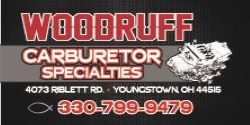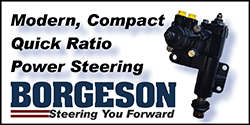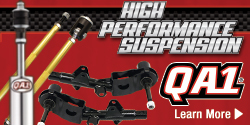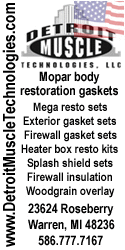AJ/FormS
Well-Known Member
- Joined
- Apr 26, 2016
- Messages
- 1,296
- Reaction score
- 306
oooo, back from the dead!
So let's play a little numbers game.
In post#12 we see that ethanol is $2.18 and regular non-oxygenated is $3.38.
Lets assume a tank size of 14 gUS and that the car can do 18mpg on the cheap stuff.
So 14x 2.18=$30.52/tank and it will drive 14x18=252 miles, on oxyginated.So this equals 30.52/252=12.11cents per mile.
Then 14x3.38=$47.32/tank, and you want to at least match the 12.11 cents per mile; so 47.32/12.11=391 miles that you would need to travel. So391/14=27.93mpgUS.
So this is the break even point. If the same car that gets 18mpg on oxygenated, can get 27.93 on non-oxyginated, then it matters not to your wallet, which fuel you burn.
Question is, is there such a car?
But lets say this is all too confusing. Well lets put it in percentages. 3.38/2.18=1.55, and 27.93/18=1.55.
So in this example,if the good fuel costs 55% more, then the car will need to get 55% better fuel mileage(to break even in cost of fuel per mile.IMHO,This is a non-possibility. Even with engines optimized in compression ratios and timing, I seriously doubt a 55% increase in fuel mileage could be achieved.
But lets look at the other example from post#8.
Here we are given numbers of 44.82 and 53.82, Again assuming a 14 gallon tank, the cost per gallon must be 3.20 and 3.84.Here the disparity is only 20%. So the increase in mileage would only need to be 20% to break even. This then, from a starting point of 18 mpg, is only 3.6mpg or 21.6mpg. this I suppose might be doable, but it begs the question "why".
For the why of it, I'll throw you a curveball. I was able to put a tune into my 68 Barracuda-367M/T, that pulled 32mpgUS, on straight hiway useage on a 600 mile run. Using oxygenated fuel. It's not a hard thing to do.I could have gone leaner.
IMO, part of the why, is in the carbs calibration, and part is in the engines age, and part is in it's design.
But yes, the 80's engines were the worst of all designs;Low compression, retarded timings,near-impossible emissions targets, and atrociously heavy cars.
So if you are enamored by this style of vehicle; it is what it is.
And,Yes I had one too for a while. Very nice ride. Nice seats.A pretty good touring car, getting 20mpgUS almost all the time, on oxygenated no less. But city driving just killed the economy.
Getting back to my 367
Or your teener for that matter.
My 367 has 10.75 Scr. with a tight squish design. on this trip I was running a 223/230/110 cam with advertised of 270/276/110. The very similar,factory 340 cam IIRC was 268/276/114. So you can see I was not that much different from a 68 spec 340,( and certainly, it was no gas mileage cam),except I have a longer stroke. And believe it or not, I was running a modified 600 Holley. My timing was 14/34/22in the can. But here's the big deal,I was running an overdrive, with a final drive about 1.97! So at 75mph, the Rs were about 1950. Now your 5th may be running a 2.45 and a loc-up, so your Rs at 65 might be 2050;about 100 rpm higher, so I was not cheating by much. In fact, I postulate that at 75mph my engine was working as hard or harder that your teener at 65.
But here's the real trick; at 1950 my 367 runs about 44* of timing. So I am starting the fire really early. I have to, to make sure every single molecule of gasoline has time to find oxygen to react with.Then I simply lean it out as far as I dare.I believe the tight squish is really contributing a lot to this theory.That and the 205* minimum running temperature. But that was what I built this engine for .....in 1999;Performance with Economy;12.9 in the qtr(with a 2.2 60ft) and 32mpgUS. And all designed around E-10.
Well in 2004, things changed. But that's another story.
So enough about what is possible, and back to dieseling. Since these engines are so "poorly designed", they are somewhat sensitive to modifying the timing. Low compression engines just are that way. However, if it was mine, I would try to increase the initial timing, little by little to see if the engine will accept it.Just remember to keep it out of high-load detonation. Sometimes you have to modify the timing curve and limit the maximum.But increasing the initial will allow you to close the butterflies, and a large curb-idle setting is the biggest offender to run-on.
Also, somewhat contrary to belief; if the EGR system is working properly, leave it alone.When it is working properly it actually benefits these old girls. If you disable it and do not change the timing and carb calibration, then there is a very real possibility that the engine will use more fuel than if it had been left alone. Remember, the EGR is inert; it does not take part in the combustion process. But when it is in there it actually cools the compressed charge, helping to reduce the tendency to run-on. It is my belief that in some small way, it also increases the effective compression ratio(Ec/r) during the times it is activated.
I mean think about it. A teener that has a per cylinder displacement of 318/8x16.387=651 cc. If it has a design compression ratio of 8/1, then it theoretically could inhale an additional 87cc of air, for a total of 738cc. Well firstly that would be 100% Volumetric Efficiency! A 5th Avenue teener ain't going there.Secondly, Egr is never operating at idle nor at full throttle nor after about 50/60% throttle-opening. Egr is a Part Throttle calibration,and begins at just above idle, reaches max-flow at maybe 35% throttle opening,and starts dropping our at say 45/50% ,so it has a very limited area of operation. So lets say the teener EGR system is able to input say 10% of the chamber as recirculated exhaust gas.And lets say the throttle is set to achieve 40% VE .Doing the math, there might be 65cc of EGR and 260cc of A/F charge, before compression starts. So that adds up to an effective compression ratio of (65+260)/87=3.73 to 1. BUT, had the EGR not been there, the effective C/R would have been 260/87=2.99 to 1. So the effective c/r was raised 3.73/2.99=1.247, or nearly 25%!
But ok, lets reset the EGR to being able to input 20% and lets reset the VE to 50%. Ok now the EGR is supplying 20%x651=130cc and the carb is allowing 50%x651=325cc. So the total volume in the chamber is 130+325=485cc and the Ec/r is 485/87=5.57. BUT, the Ec/r without EGR would be 325/87=3.73....AND the Ec/r increase would be 5.57/3.73=1.493, or nearly 50% !
Ok so some will want to correct me and say that whatever air enters the chamber fills it completely and so technically you can't put just "X" amount of air in there! Well that would be correct. But that full cylinder at 50% VE would have only one half the oxygen molecules in it that it could theoretically have, at 100%VE. So to those guys I say "6 of these or a half dozen of those". My way of explaining this avoids the extra math, that is all.
Now, these older systems don't input that much EGR. But they could be made to.....
The trick would be in controlling it, so as to maximize it's introduction without running into detonation problems. And that's where EFI comes in. Just put a scanner on your EFI car sometime and watch what the EGR system does!
Well enough bs for today,lol.
Hope you solved your run-on issue.....
Oh and in case you missed it, if the EGR is defeated or just doesn't work,AND,you made no other changes,then the loss of Ec/r will require you to open the throttle a little further under all Part Throttle conditions during which the EGR system should have been working. And that is where the gas mileage went. You can get it back, but it will cost you money and time, so why try to out-think the Chrysler engineers on this one......I'm sure they spent hundreds of hours in the design and testing of it.
But if you're sharp and love a challenge, have at it!
As for me, I would be looking at ways of increasing EGR, and re-tuning the engine to be compatible with it.But that's just the way I roll..............................
Peace/out
So let's play a little numbers game.
In post#12 we see that ethanol is $2.18 and regular non-oxygenated is $3.38.
Lets assume a tank size of 14 gUS and that the car can do 18mpg on the cheap stuff.
So 14x 2.18=$30.52/tank and it will drive 14x18=252 miles, on oxyginated.So this equals 30.52/252=12.11cents per mile.
Then 14x3.38=$47.32/tank, and you want to at least match the 12.11 cents per mile; so 47.32/12.11=391 miles that you would need to travel. So391/14=27.93mpgUS.
So this is the break even point. If the same car that gets 18mpg on oxygenated, can get 27.93 on non-oxyginated, then it matters not to your wallet, which fuel you burn.
Question is, is there such a car?
But lets say this is all too confusing. Well lets put it in percentages. 3.38/2.18=1.55, and 27.93/18=1.55.
So in this example,if the good fuel costs 55% more, then the car will need to get 55% better fuel mileage(to break even in cost of fuel per mile.IMHO,This is a non-possibility. Even with engines optimized in compression ratios and timing, I seriously doubt a 55% increase in fuel mileage could be achieved.
But lets look at the other example from post#8.
Here we are given numbers of 44.82 and 53.82, Again assuming a 14 gallon tank, the cost per gallon must be 3.20 and 3.84.Here the disparity is only 20%. So the increase in mileage would only need to be 20% to break even. This then, from a starting point of 18 mpg, is only 3.6mpg or 21.6mpg. this I suppose might be doable, but it begs the question "why".
For the why of it, I'll throw you a curveball. I was able to put a tune into my 68 Barracuda-367M/T, that pulled 32mpgUS, on straight hiway useage on a 600 mile run. Using oxygenated fuel. It's not a hard thing to do.I could have gone leaner.
IMO, part of the why, is in the carbs calibration, and part is in the engines age, and part is in it's design.
But yes, the 80's engines were the worst of all designs;Low compression, retarded timings,near-impossible emissions targets, and atrociously heavy cars.
So if you are enamored by this style of vehicle; it is what it is.
And,Yes I had one too for a while. Very nice ride. Nice seats.A pretty good touring car, getting 20mpgUS almost all the time, on oxygenated no less. But city driving just killed the economy.
Getting back to my 367
Or your teener for that matter.
My 367 has 10.75 Scr. with a tight squish design. on this trip I was running a 223/230/110 cam with advertised of 270/276/110. The very similar,factory 340 cam IIRC was 268/276/114. So you can see I was not that much different from a 68 spec 340,( and certainly, it was no gas mileage cam),except I have a longer stroke. And believe it or not, I was running a modified 600 Holley. My timing was 14/34/22in the can. But here's the big deal,I was running an overdrive, with a final drive about 1.97! So at 75mph, the Rs were about 1950. Now your 5th may be running a 2.45 and a loc-up, so your Rs at 65 might be 2050;about 100 rpm higher, so I was not cheating by much. In fact, I postulate that at 75mph my engine was working as hard or harder that your teener at 65.
But here's the real trick; at 1950 my 367 runs about 44* of timing. So I am starting the fire really early. I have to, to make sure every single molecule of gasoline has time to find oxygen to react with.Then I simply lean it out as far as I dare.I believe the tight squish is really contributing a lot to this theory.That and the 205* minimum running temperature. But that was what I built this engine for .....in 1999;Performance with Economy;12.9 in the qtr(with a 2.2 60ft) and 32mpgUS. And all designed around E-10.
Well in 2004, things changed. But that's another story.
So enough about what is possible, and back to dieseling. Since these engines are so "poorly designed", they are somewhat sensitive to modifying the timing. Low compression engines just are that way. However, if it was mine, I would try to increase the initial timing, little by little to see if the engine will accept it.Just remember to keep it out of high-load detonation. Sometimes you have to modify the timing curve and limit the maximum.But increasing the initial will allow you to close the butterflies, and a large curb-idle setting is the biggest offender to run-on.
Also, somewhat contrary to belief; if the EGR system is working properly, leave it alone.When it is working properly it actually benefits these old girls. If you disable it and do not change the timing and carb calibration, then there is a very real possibility that the engine will use more fuel than if it had been left alone. Remember, the EGR is inert; it does not take part in the combustion process. But when it is in there it actually cools the compressed charge, helping to reduce the tendency to run-on. It is my belief that in some small way, it also increases the effective compression ratio(Ec/r) during the times it is activated.
I mean think about it. A teener that has a per cylinder displacement of 318/8x16.387=651 cc. If it has a design compression ratio of 8/1, then it theoretically could inhale an additional 87cc of air, for a total of 738cc. Well firstly that would be 100% Volumetric Efficiency! A 5th Avenue teener ain't going there.Secondly, Egr is never operating at idle nor at full throttle nor after about 50/60% throttle-opening. Egr is a Part Throttle calibration,and begins at just above idle, reaches max-flow at maybe 35% throttle opening,and starts dropping our at say 45/50% ,so it has a very limited area of operation. So lets say the teener EGR system is able to input say 10% of the chamber as recirculated exhaust gas.And lets say the throttle is set to achieve 40% VE .Doing the math, there might be 65cc of EGR and 260cc of A/F charge, before compression starts. So that adds up to an effective compression ratio of (65+260)/87=3.73 to 1. BUT, had the EGR not been there, the effective C/R would have been 260/87=2.99 to 1. So the effective c/r was raised 3.73/2.99=1.247, or nearly 25%!
But ok, lets reset the EGR to being able to input 20% and lets reset the VE to 50%. Ok now the EGR is supplying 20%x651=130cc and the carb is allowing 50%x651=325cc. So the total volume in the chamber is 130+325=485cc and the Ec/r is 485/87=5.57. BUT, the Ec/r without EGR would be 325/87=3.73....AND the Ec/r increase would be 5.57/3.73=1.493, or nearly 50% !
Ok so some will want to correct me and say that whatever air enters the chamber fills it completely and so technically you can't put just "X" amount of air in there! Well that would be correct. But that full cylinder at 50% VE would have only one half the oxygen molecules in it that it could theoretically have, at 100%VE. So to those guys I say "6 of these or a half dozen of those". My way of explaining this avoids the extra math, that is all.
Now, these older systems don't input that much EGR. But they could be made to.....
The trick would be in controlling it, so as to maximize it's introduction without running into detonation problems. And that's where EFI comes in. Just put a scanner on your EFI car sometime and watch what the EGR system does!
Well enough bs for today,lol.
Hope you solved your run-on issue.....
Oh and in case you missed it, if the EGR is defeated or just doesn't work,AND,you made no other changes,then the loss of Ec/r will require you to open the throttle a little further under all Part Throttle conditions during which the EGR system should have been working. And that is where the gas mileage went. You can get it back, but it will cost you money and time, so why try to out-think the Chrysler engineers on this one......I'm sure they spent hundreds of hours in the design and testing of it.
But if you're sharp and love a challenge, have at it!
As for me, I would be looking at ways of increasing EGR, and re-tuning the engine to be compatible with it.But that's just the way I roll..............................
Peace/out
Last edited:















